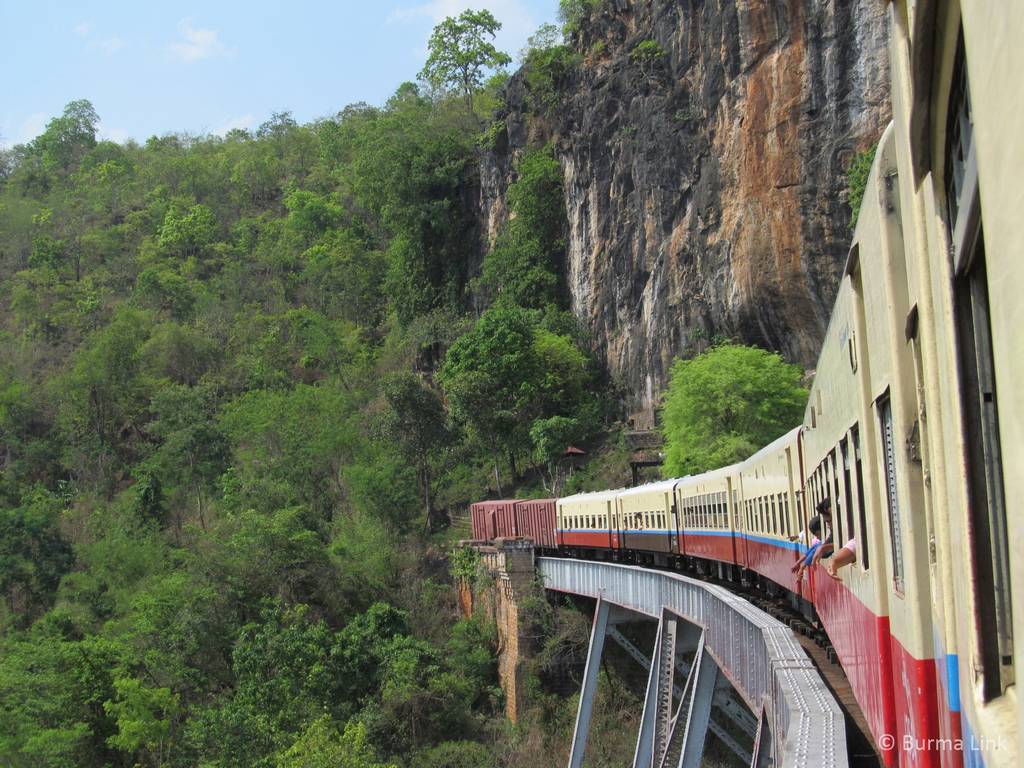Sources have been omitted with regards to general information on history. Refer to sources for history of Burma at the end of the document. For a multi-ethnic perspective on conflict in Burma, go to Dynamics of Ethnic Conflict.
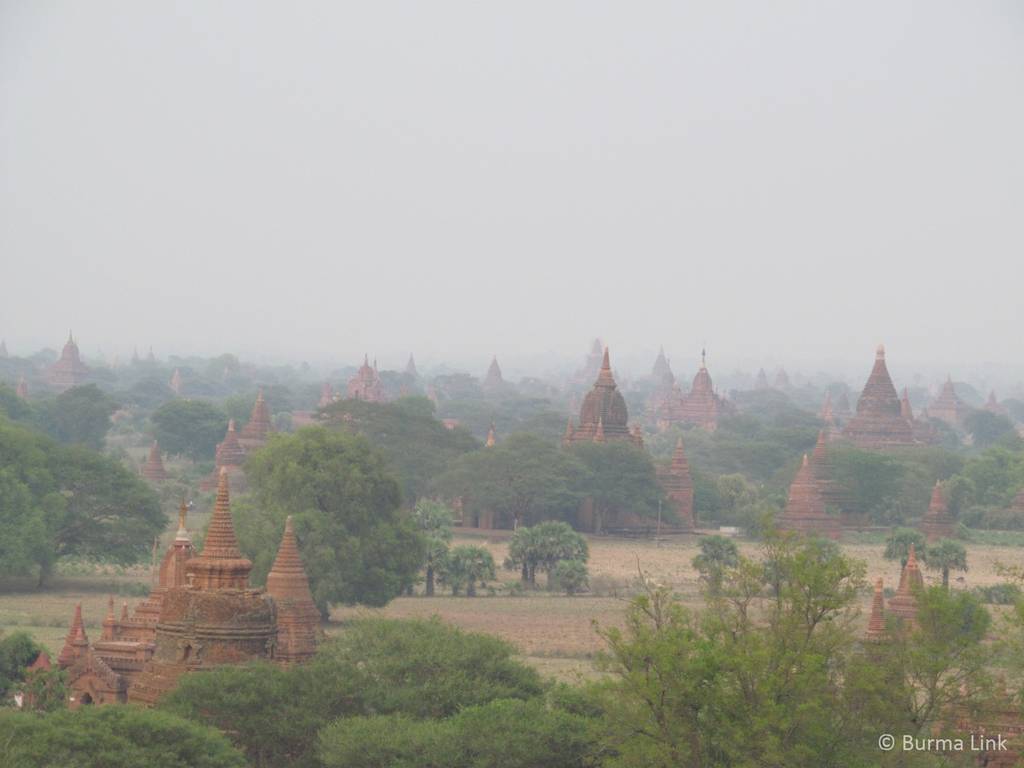
Bagan, Mandalay Region. View from Swesandaw pagoda, a popular sunset destination. (Photo: Liz Bordo)
The British rule completely transformed the society in Burma, bringing several enduring social, economic and cultural changes to the country. Although many missionaries during the British rule were trying to do good things for the people by developing written languages, building schools and clinics, and improving the standard of living, their activities also caused tensions between different groups in Burma. Whereas some ethnic peoples celebrated the changes brought by the British, others fought relentlessly to end the foreign occupation.
The British built two separate systems of administration; ‘Ministerial Burma’ or ‘Burma Proper’, dominated by the Burman majority, and the ‘Frontier Areas’, populated mainly by ethnic nationalities. Much to the resentment of the Burman majority, the Frontier Areas were for the most part left under the control of traditional rulers and chiefs, and the Karen, Kachin and Chin were preferred for recruitment into the colonial armed forces. This strict division set the different groups in Burma on separate roads towards political and economic development, exacerbated the ethnic cultural differences, and widened the pre-existing cleavages among the myriad ethnic groups. The division of Burma into two main administrative areas was of particular importance for the relations between the majority Burman and ethnic nationalities, and the divide and rule policy of the British had far-reaching consequences for Burma’s future.
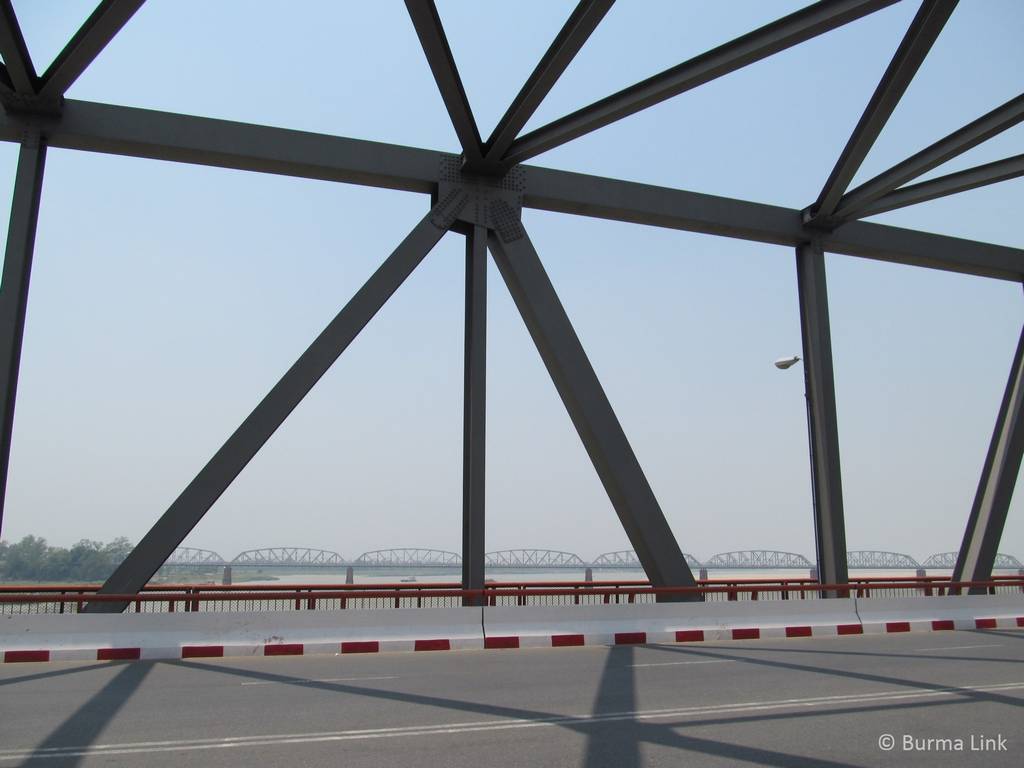
Ava bridge, over the Irrawaddy river, connecting Ava with Sagaing. The bridge was built by the British in 1934, destroyed by the retreating British army during the World War II, and rebuilt in 1954. (Photo: Liz Bordo)
Burma’s independence was largely influenced by a group of Burmese nationalists led by General Aung San. This group of 30 Burmese youths known as ’30 Comrades’ was trained by the Japanese who secretly promised to help Burma recover its freedom from the British. They were to form Burma Independence Army (BIA), which later became a nucleus of the national army of Burma. At the outbreak of World War II, BIA drove out the British with the help of the Japanese. BIA then occupied ethnic nationality areas along with the Japanese forces, which were known for their cruel practices and human rights abuses. The relationship between Burma’s national liberation movement and ethnic nationalities was also strained by the fact that during the war, most ethnic peoples stayed loyal to the British and fought side by side with them against the Japanese and BIA. After driving out the British, BIA transformed itself into the Anti-Fascist People’s Freedom League (AFPFL), switched sides and joined the Allies, and aided the U.S. and the British in liberating Burma from Japan. The war years played an important role in after-war hostility between the Burmese army and ethnic opposition groups.
After the war a delegation of Burmese nationalists, with General Aung San at the helm, negotiated with the British and demanded complete political and economic independence from Britain. The so-called Aung San- Attlee Agreement, signed on January 27, 1947, stated that Burma would get independence within one year and that the Frontier Areas would be united with Burma Proper. Many ethnic leaders did not support the agreement as they wanted to protect their right to self-determination and believed that the British would support them as they had promised.
While the British had been negotiating with ethnic nationality leaders before independence, General Aung San had also toured around Frontier Areas trying to win the confidence and trust of ethnic nationality peoples and convincing them to join the Union of Burma. Some principles for the country’s new constitution were hastily agreed at the historic Panglong Conference organised in February 1947, where Burman, Kachin, Shan, and Chin leaders, as well as Karen leaders as observers only, met to discuss their plans for the future. Mon, Arakanese, Karenni, and other nationalities were not invited or were not interested in taking part. The agreement included a ‘Principle of Equality’ between Burmans and ethnic nationalities, and in the conference, General Aung San famously promised: “If Burma receives one kyat, you will also get one kyat”. Nevertheless, in the absence of many ethnic leaders as well as common agreement, the 1947 constitution ended up riddled with anomalies on ethnic rights. The Shan, Kachin, and Karenni were awarded the voluntary right of secession after a 10-year period while the Mon and Arakanese ended up without a state of their own. A much-promised Karen State also remained undemarcated.
Six months before reaching independence, on July 19, 1947, General Aung San and eight of his cabinet ministers were assassinated by a gang of armed paramilitaries while holding a meeting of the Executive Council. Tragically, the assassination and the rapid British exit from Burma meant that the issues between different ethnic groups were never fully resolved. While General Aung San was not supported by all people of Burma, he was still perhaps Burma’s only hope in holding the myriad ethnic groups together in peace. He was widely trusted and respected due to his direct and honest character and many people believe that Burma would be very different today if General Aung San had lived. With Burma’s national hero perished, a civilian and a close colleague of Aung San, U Nu, became the prime minister and led Burma to independence. U Nu introduced a parliamentary federal union system as the basis of the system of government.
Burma gained independence at the auspicious time of 4.20 am on January 4, 1948. Burma’s independence was, however, born out of bloodshed. Much of the ethnic hostility that erupted can be attributed to the war years. The country rapidly spiraled into increasing intercultural violence between the national Burmese army and ethnic opposition armies. The Communist Party of Burma (CPB) and the Karen National Liberation Army (KNLA), the armed wing of the Karen National Union (KNU), revolted within the first year of independence. In quick succession, various other ethnic groups, including the Karenni, Mon, Pa’o, Kachin, and Arakanese took up arms in the countryside. This was the beginning of the longest running civil war in the world.
While the situation in Burma improved somewhat in the late 1950s, underlying ethnic tensions remained and the situation quickly deteriorated when ethnic nationality leaders realised that the Burmese government would not respect the promises they had made at independence. Panglong Agreement was not honoured and furthermore, Buddhism was declared a state religion much to the resentment of ethnic nationalities, whose populations had largely been converted to Christianity during the colonial times.
In 1962, General Ne Win ceased power in a military coup and the multi-party federal union was transformed into a single party state where the Burma Socialist Programme Party (BSPP) was the sole legal political entity allowed to operate in the country. Following unsuccessful peace talks with many of the different armed opposition groups, Ne Win embarked on his experiment with the ‘Burmese Way to Socialism’. He abandoned General Aung San’s ‘Unity in Diversity’ and the federal structure of the 1947 Constitution, adopting to run an all-out counterinsurgency campaign in the rural countryside. Many serious human rights violations became first systematised under the BSPP government and Burma was turned into one of the world’s most impoverished countries. Speaking out against the regime became punishable and freedom of association, press, and assembly were severely repressed.
For the next 12 years until 1974, the country was ruled under Martial law. General Ne Win dominated the government from 1962 to 1988, first as a military ruler and then as a self-appointed president. Popular unrest drove the people of Burma repeatedly on to the streets, including student led protests in 1965, 1969, 1970 and 1974. In 1974, workers throughout the nation participated in a strike, to which the government responded by shooting an estimated 100 workers and students on June 6, 1974. National Democratic Front (NDF), a political party comprising of nine ethnic organisation members was founded on May 10, 1976. Many ethnic nationalities were largely in control of their traditional areas along the outlying Thai borderlands until 1984 when a brutal Burmese offensive near the Thai border drove 10,000 refugees to flee into Thailand. This event marked the beginning of the ongoing refugee outflow from Burma into Thailand.
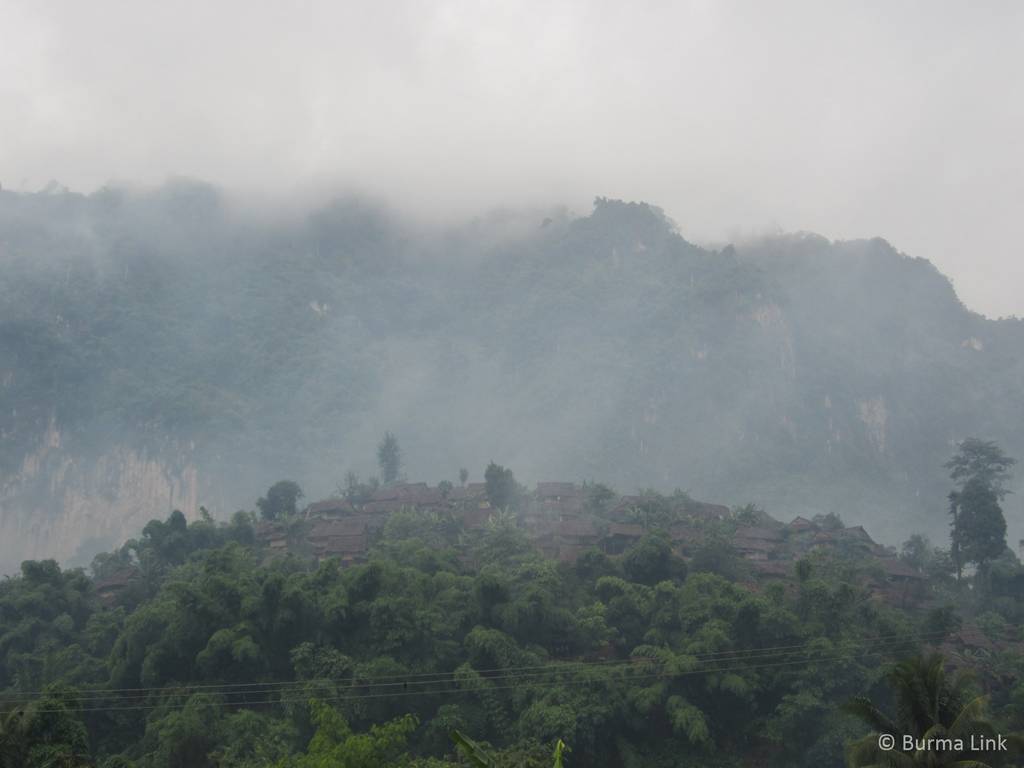
View of Mae La refugee camp that has been located at the Thailand-Burma border since 1984 and is now home to about 45,000 Burmese refugees. (Photo: Ariana Zarleen)
In 1987, the government, without warning, demonetised all bank notes that were not divisible by nine, presumably because Ne Win was told that number nine was his lucky number. No reimbursement was offered although nearly 70 % of the currency in circulation became worthless. The same year Burma was admitted to ‘Least Developed Country’ status at the United Nations as one of the world’s ten poorest countries. In 1988, students began protesting against the government, demanding that the BSPP step aside in favour of a democratically elected civilian government. Authorities responded by closing universities for several months, leading to even more civil unrest. In what came to be known as the 8888 uprising on August 8, 1988, hundreds of thousands of students, monks, and people from all ethnicities and walks of life poured on to the streets and demonstrated against the regime. The military and the police ceased the protests by attacking the people with tear gas, guns and tanks, firing directly into the crowds and killing thousands of people. The leaders of the student movement were imprisoned and tortured, and countless of others were arrested and harassed for taking part in or observing the demonstrations. On August 28, 1988, the students formed an umbrella organisation comprising of all the student unions. The All Burma Federation of Student Unions (ABFSU) became an active voice for academic freedom and student rights.
Following the growing unrest Ne Win resigned and was replaced by a civilian lawyer Dr. Maung Maung. In September 1988 the military staged a coup and established a new dictatorship under martial law, called the State Law and Order Restoration Council (SLORC). The SLORC insisted that they merely wanted to restore order and promised to organise multiparty elections as soon as possible. It was widely believed however, that Ne Win orchestrated the coup from behind the scenes. After the SLORC’s assumption of power up to 10,000 students and democracy activists took sanctuary around Burma’s outlying areas, which were largely controlled by insurgent forces such as CPB and KNU. Operating from the KNU controlled areas the students formed the All Burma Students Democratic Front (ABSDF) and took up arms against the government.
1988 turned out to be a decisive year for the people of Burma as it also witnessed the emergence of Daw Aung San Suu Kyi, daughter of the national hero General Aung San, as a national icon. While she originally returned to attend to her sick mother, on August 26, 1988, Daw Aung San Suu Kyi addressed half a million people at a mass rally in front of the Shwedagon Pagoda, calling for a democratic government. A month later, she helped found the National League for Democracy (NLD) which quickly emerged as the leading opposition party. Daw Suu Kyi began campaigning all over the country, gathering significant crowds where ever she travelled. In 1989 the SLORC became tired of her popularity, put her under house arrest on July 20, and disqualified her from participating in the elections.
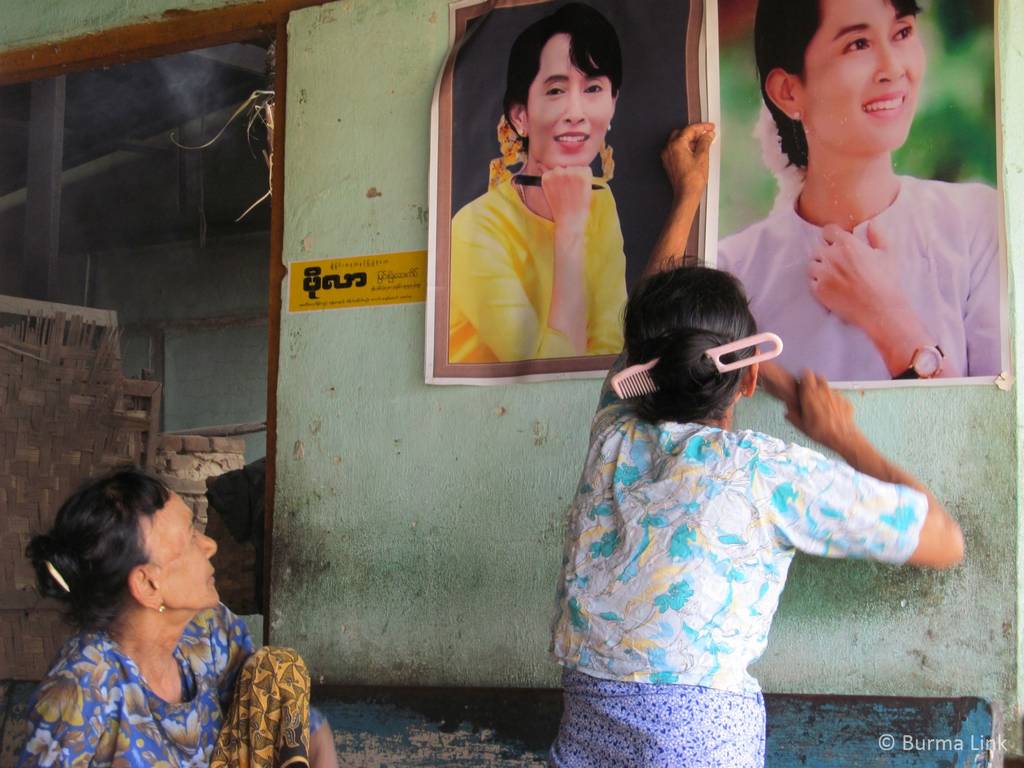
Woman hanging a poster of Daw Aung San Suu Kyi after cleaning it, Nyaung U jetty. (Photo: Liz Bordo)
Soon after, the government declared martial law and in a violent crackdown arrested thousands of civilians, students and other key political figures, including most of the NLD’s senior leaders. Despite the government’s attempts to weaken the opposition, the people of Burma voted overwhelmingly for NLD in the elections in May 1990; NLD won 392 of the 485 seats contested, while the SLORC backed National Unity Party (NUP) won 10 seats. Unsatisfied with the election outcome, the government ignored the result and refused to hand over power. Over 100 of the 485 elected members of parliament were arrested or forced to renounce politics while another 20 members of parliament, along with thousands of students and democracy activists, escaped into exile or into territory controlled by the CPB or KNU. In the 1990s, the student army ABSDF had about 10,000 members and waged a guerrilla war against the Burmese army from the mountains of the Karen state.
The period 1988-1992 witnessed some of the heaviest fighting in Burma since independence. In 1989 SLORC began offering selective ceasefires to a number of ethnic nationality armies while simultaneously sending over 80,000 troops into action against KNU and various Mon, Kachin and Karenni armed insurgency groups. During the same period, over 200,000 Muslims from the Arakan State also fled into neighbouring Bangladesh. In late 1988, the Democratic Alliance of Burma (DAB) was formed, including all the members of the NDF as well as ABSDF and the All Burma Young Monks’ Union (ABYMU). ABYMU had been formed after independence, banned alongside with all civil and political organisations in 1964, and re-established after the 8888 uprising. With a full support of NDF and DAB, the National Coalition Government of the Union of Burma (NCGUB), the Government in exile, was formed on December 18, 1990.
Although the military government had changed the official country name from Burma to Myanmar in 1989, a year after thousands were killed in the suppression of the uprising, many organisations and foreign governments, including the U.S. and the UK, continued to refer to the country as Burma. Burma’s democracy movement has also preferred the form Burma as they do not accept the legitimacy of the unelected military regime to change the official name of the country. Nevertheless, the change was recognised by the United Nations as well as by countries such as France and Japan. In 1990 the UN Commission on Human Rights began its ongoing investigation into human rights abuses in Burma.
Particularly during the 1990s the Burmese army maintained its strategy to weaken the opposition armies by offering selective ceasefire agreements, which ignore the political concerns of the ethnic nationality groups while offering many other benefits and privileges to those who agree to them. Ceasefires in Burma have been highly controversial; history has shown that human rights abuses in Burma can occur in wartime and peacetime alike and that ceasefire agreements between fighting parties do not necessarily lead to an end of abuses against civilians (see Patterns of state abuse). On the contrary, ceasefires have often led to splits in the opposition movement, resulting in more tension and fighting, all the while pushing aside the original goals of the opposition movement. While the Burmese army signed a number of agreements in the 1990s, the refugee flows from Burma to Thailand began to increase. By mid-1990s over one million refugees and migrants, mostly belonging to ethnic nationalities, had fled across Burma’s troubled borders and hundreds of thousands of others were displaced inside Burma itself.
In 1991, Daw Aung San Suu Kyi won the Nobel Peace Prize for her non-violent struggle for peace and democracy. Still under house arrest, she was unable to attend the ceremony. The junta released Daw Aung San Suu Kyi in 1995 but placed under house arrest again from September 2000 to May 2002, and from May 2003 to November 2010, when she was released one week after the 2010 elections. Daw Aung San Suu Kyi has spent 15 years under house arrest, unable to see her children or her British husband who passed away while she was held a prisoner in her own house. The military government offered to release her but she repeatedly refused, knowing that she would not be allowed re-entry to the country. Her sacrifice of personal freedom has become a unifying element across all peoples of Burma and she has won the hearts of all who care about freedom and justice.
In 1997, the Burmese government changed its name to State Peace and Development Council (SPDC) and Burma was admitted into the Association of Southeast Asian Nationals (ASEAN). The International Labour Organization (ILO) formed a Commission of Inquiry into Burma in 1997, and found a prolific use of forced labour in the country (ILO, 1998). Throughout the 1990s, the SPDC continued to persecute students and target political opposition. In May 2003, when Daw Aung San Suu Kyi had been released from house arrest and was attempting to organise NLD activities outside of Rangoon, the Burmese army attacked her supporters injuring and killing dozens of people. This event has become known as the Depayin Massacre (see ALRC, 2004).
In 2005, the students who were active during the 1988 uprising, and many of whom were imprisoned and sentenced, founded the pro-democracy movement 88 Generation Students Group (also called 8888 Generation Students Group) nearly two decades later when they had finally been released. Since then, the 88 Generation students have launched a series of civil-disobedience campaigns openly challenging the military government, including collecting 535,580 signatures for a petition calling for the release of all Burma’s political prisoners. The petition was subsequently sent to the SPDC as well as various UN organizations (Lintner, January, 2007).
In March 2006, the military government officially relocated the capital to Naypyidaw, which is more centrally and strategically located than the old capital Rangoon. Many have speculated that the government was concerned with the possibility of a foreign military attack, and the popular belief among the Burmese is that a warning about an attack was delivered to the military chief by an astrologer.
The next large-scale protests in Burma broke out in 2007, again triggered by economic desperation. The SPDC decided to increase fuel prices by 500% overnight, causing the prices of food and other commodities to soar to unattainable heights for a large part of the population. In what came to be known as the Saffron Revolution, thousands of monks participated in peaceful protests on the streets of all major cities, soon to be joined by tens of thousands of pro-democracy activists, nuns, students, and local residents from all walks of life. The demonstrators demanded political and economic change in Burma but once again, the military brutally suppressed the protests and killed an unknown number of monks and civilians. The military also arrested thousands of people for participating in the demonstrations. Even though images and videos of the protests were making their way to the international community, the military continued with arrests and killings.
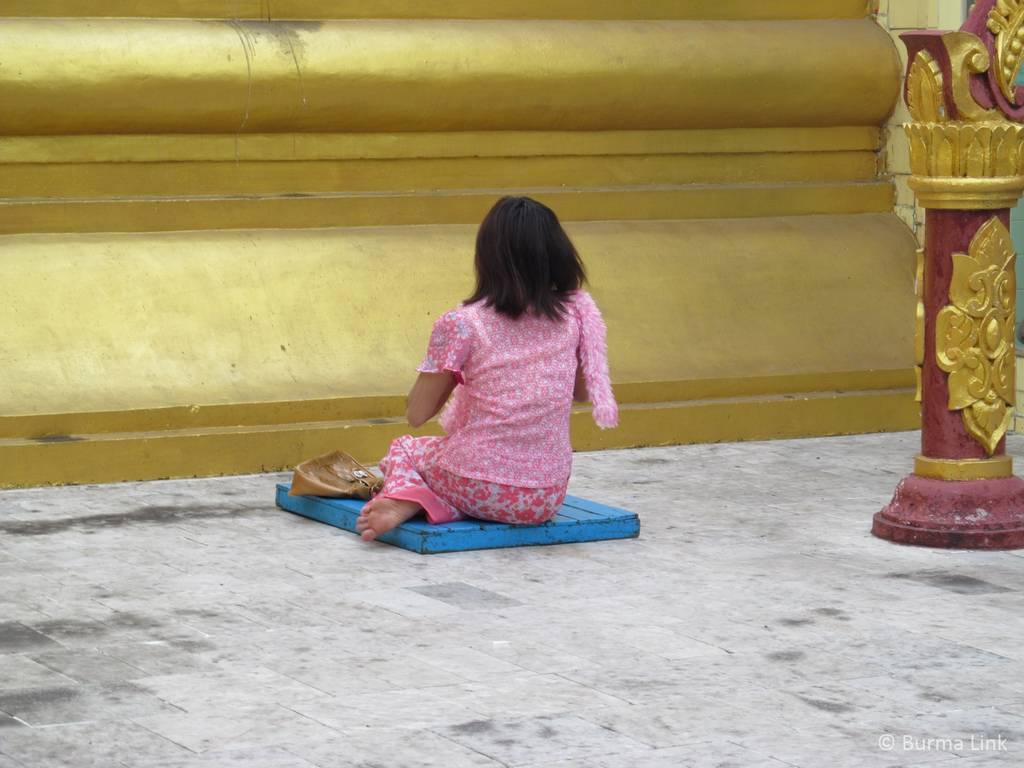
A woman praying at Sule Pagoda, Rangoon. This pagoda was a rallying place during both the 8888 uprising and the Saffron revolution. (Photo: Liz Bordo)
The next tragedy was only waiting around the corner as Burma was struck by Cyclone Nargis in May 2008. The storm killed between 100,000 and 200,000 people, devastated millions of acres of farmland and levelled hundreds of communities. Despite the widespread destruction and urgent aid needed by the survivors, the military government closed their borders and prevented international aid from reaching the populations in need; thousands more people perished as a result of the government’s actions. Ethnic Karen people residing in the delta region were especially adversely affected by the cyclone, leading to a sharp increase in food and livelihood insecurity among the Karen.
A few days after the cyclone had devastated the lives of hundreds of thousands, the government held a referendum vote. 92% of voters rendered their approval for the new constitution and the accompanying roadmap to democracy in elections that were likely to be neither free nor fair (e.g. ALTSEAN-Burma, 2008; Laden, 2012).
“When we went for the referendum, we had to vote ‘yes’. If we had voted ‘no’, they would have punished us. They watched us closely, so all of us voted ‘yes”. (Karen woman, CDKIP focus group, Kuakgyi Township, June 2008; TBC, 2008, p. 6)
The 2008 Constitution, similarly to the 1947 Constitution, has been criticised for its inadequacy to regard the different ethnic groups of Burma. It also has several articles underlining the role of the military regime in participating in political leadership; the constitution guarantees that the military will be beyond any civilian control, it will nominate and hold 25% of the seats and positions in legislative and executive bodies at all levels of the administration, and the military will be in charge of the defence and security affairs without any civilian control. The constitution seemed to be yet another way to strengthen the military’s power grip behind a facade of democracy (see ALTSEAN-Burma, 2010, 2011).
Under the 2008 Constitution, the government also demanded that all of the ceasefire groups be incorporated into a united Border Guard Force (BGF), which would entail disarming the groups and re-supplying them with government-issued weapons. Their troops would also become subordinate to regional Burmese military commanders. Only a few groups, among them the Democratic Karen Buddhist Army (DKBA) and the National Democratic Army-Kachin, have agreed to join. The refusal to join the BGF resulted in military offensives launched by the Burmese army, and, as a consequence, to increased refugee flows across Burma’s borders. Although the Burmese government ended its call for armed resistance groups to transform into BGF in October 2011, tensions caused war to break out between the Burmese military and ethnic armies in Kachin, Shan, Karen, and Mon states. Two main areas affected were Kachin and Shan states, where fighting between the Burmese army and ethnic opposition armies largely broke out as a result of their refusal to join BGF.
The first parliamentary elections since 1990 were held in November 2010. The military-backed Union Solidarity and Development Party (USDP) won over 75% of the vote in elections that according to foreign observers were again neither free nor fair (BBC, November, 2010). A nominally civilian parliamentary government, comprised mostly of former generals, took power in March 2011, and the former Prime Minister Thein Sein was selected as the president.
Shortly after the 2010 election, the Burmese army began negotiating ceasefires with various ethnic resistance movements. Concerned that negotiations were taking place individually at the local levels, twelve ethnic armies joined together in November 2010 to form the United Nationalities Federal Council (UNFC) in order to ensure that any peace talks would be held through a common framework (Keenan, May, 2012).
Although Burma continues to be ruled by the military, the new government has surprised everyone by initiating a series of political and economic reforms since its assumption of power. The government has released hundreds of political prisoners, enacted laws on forming trade unions and freedom of assembly, eased official media censorship, allowed Daw Aung San Suu Kyi to run in the April 2012 by-elections in which she won a seat in the Parliament, and signed a number of ceasefires with armed ethnic nationality groups. Nevertheless, many question the intentions of the new ‘civilian government’ and countless of explanations have been put forward as to why the government has initiated the reforms. A number of recent reports have also recorded a continuance of systematic human rights violations in Burma’s prisons and ethnic areas (see Human rights reports), and furthermore, ceasefires in Burma remain a problematic issue.
Democracy in itself is nothing new to Burma and it has been a recurrent topic in protests around the country ever since the 1962 coup. Over the decades of military dictatorship in Burma, numerous protests and demonstrations opposing successive regimes have been organised on the streets of cities and towns, typically led by monks or students. Whilst many of these protests and uprisings have been brutally cracked down by the military and security forces, they have also led to social changes such as more organised opposition movements. Nevertheless, despite the widely held support for democracy, the country has failed to restore democratic rule for a half a century while the military violently suppressed the nationwide 8888 uprising as well as the monk-led Saffron uprising in 2007. With Burma’s history of initial transition to democracy destroyed, and all subsequent attempts violently suppressed, any future transition carries with it the scars from the past historical struggles. Positive changes seem to be on the way in Burma, and many are now holding their breath hoping that the changes are genuine. However, there are now worrying signs that the reform process is backtracking (TBC, 2014a). Furthermore,across the country, many communities and regions are now polarised along ethnic, political or religious lines. Even if peace is achieved and sustained, the task of social reconstruction now facing the country is immense. Only time will tell how the changes will affect the people of Burma and whether the government truly wants change. (for more information, refer to Recent Developments).
Updated October 10, 2014
Continue to Dynamics of Ethnic Conflict
Charney, M. W. (2009). A History of Modern Burma. Cambridge: Cambridge University Press.
Fink, C. (2001). Living Silence: Burma Under Military Rule. London: Zen Books Ltd.
Silverstein, J. (1980). Burmese Politics and the Dilemma of National Unity. New Jersey:Rutgers University Press.
Smith, M. (1991). Burma: Insurgency and Politics of Ethnicity. London: Zed Books Ltd..

